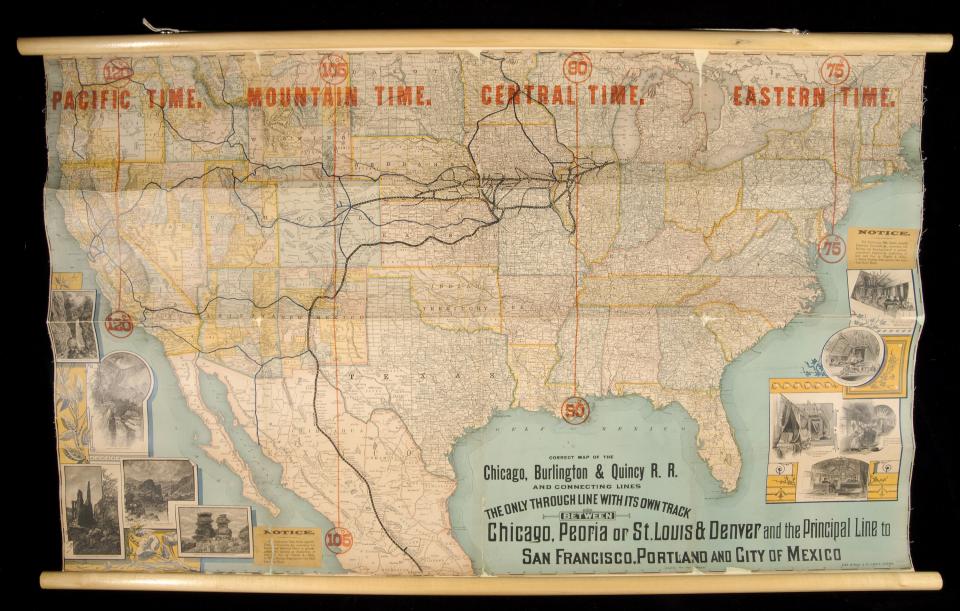“The sun will be requested to rise and set by railroad time”
Railroad time is to the time of the future. The Sun is no longer to boss the job. People—all 55,000,000 of them—must eat, sleep and work as well as travel by railroad time. It is a revolt, a rebellion. The sun will be requested to rise and set by railroad time. The planets must, in the future, make their circuits by such timetables as railroad magnates arrange. People will have to marry by railroad time, and die by railroad time. Ministers will be required to preach by railroad time—banks will open and close by railroad time—in fact, the Railroad Convention has taken charge of the time business, and the people may as well set about adjusting their affairs in accordance with its decree… . We presume the sun, moon and stars will make an attempt to ignore the orders of the Railroad Convention, but they, too, will have to give in at last.
—Indianapolis Sentinel, 21 November 1883
Just as the General Land Office surveys ordered the land into rectangular townships and sections, the railroads imposed a new spatial and temporal order based on where their tracks were laid and the arrival and departure times of trains. Before the railroads, travel times beyond a day’s hike were slow and often unpredictable. It might take a farmer several days to bring his produce to a market. A lame ox or horse, a broken wheel, or wet weather that transformed roads to mud could turn those days into weeks. Since travel by water took so long, there was little incentive for a prompt departure. Indeed, it was prudent to wait until the ship was full and the weather was favorable. In the late fall, missing the boat could mean waiting until spring until the next one. On the other hand, for trains punctuality and regularity increased efficiency and profits. By speeding up travel and decreasing time spent waiting, trains caused people to perceive time as more valuable than they had before.
An equally dramatic way in which the railroads influenced the way people perceived time was by getting together in 1883 to establish four time zones based on the 75th, 90th, 105th, and 120th meridians. The first map, dated 1880, shows the CB&Q system before the implementation of the railroads’ Standard Time System. The second map, dated 1885, boldly declares the new time regime.

1880 map of the Chicago, Burlington & Quincy Railroad.
1880 map of the Chicago, Burlington & Quincy Railroad.
Courtesy of Newberry Library.
Used with permission of the Newberry Library. With questions about reuse of this image, contact the Newberry Library.
The copyright holder reserves, or holds for their own use, all the rights provided by copyright law, such as distribution, performance, and creation of derivative works.
The 1880 map shows Chicago as a crossroads of transportation, with rail lines radiating out in all directions except where Lake Michigan represents its shipping lanes. The map depicts the early heart of the CB&Q, from northern Illinois through southern Iowa and northern Missouri, with Chicago at the center of the map. The inset shows the “short route to California,” via the CB&Q, Hannibal & St. Joseph, and Kansas Pacific railroads. Although the CB&Q was not a transcontinental railroad and did not really aspire to become one, it still held a strategic position as a link between the Atlantic and Pacific coasts (click on the map to see a more detailed view of the inset).
Between 1850 and 1880 the population of Chicago increased from less than 30,000 to more than half a million. It was the center of a vast and growing rail and shipping network. Building materials, manufactured goods, and settlers traveled west along the rails. While agricultural products—grain and animals—and raw materials were sent east to Chicago. Railroads had defied seasons and annihilated space, but had not yet standardized time.

Map of the Chicago, Burlington & Quincy R.R. and connecting lines, 1885.
Map of the Chicago, Burlington & Quincy R.R. and connecting lines, 1885.
Courtesy of Newberry Library.
Used with permission of the Newberry Library. With questions about reuse of this image, contact the Newberry Library.
The copyright holder reserves, or holds for their own use, all the rights provided by copyright law, such as distribution, performance, and creation of derivative works.
In 1883 the US railroads called a General Time Convention to develop a more coordinated and orderly system. In October of 1883 delegates met at the Pacific Hotel in Chicago and on 11 October 1883 adopted the Standard Time System which went into effect on 18 November 1883. Although the US Congress did not officially recognize the Standard Time System until 19 March 1918 when it passed the Standard Time Act, cities, states, and the federal government began using the system soon after the railroad implemented it. This map shows the four time zones agreed upon by the railroads.



















